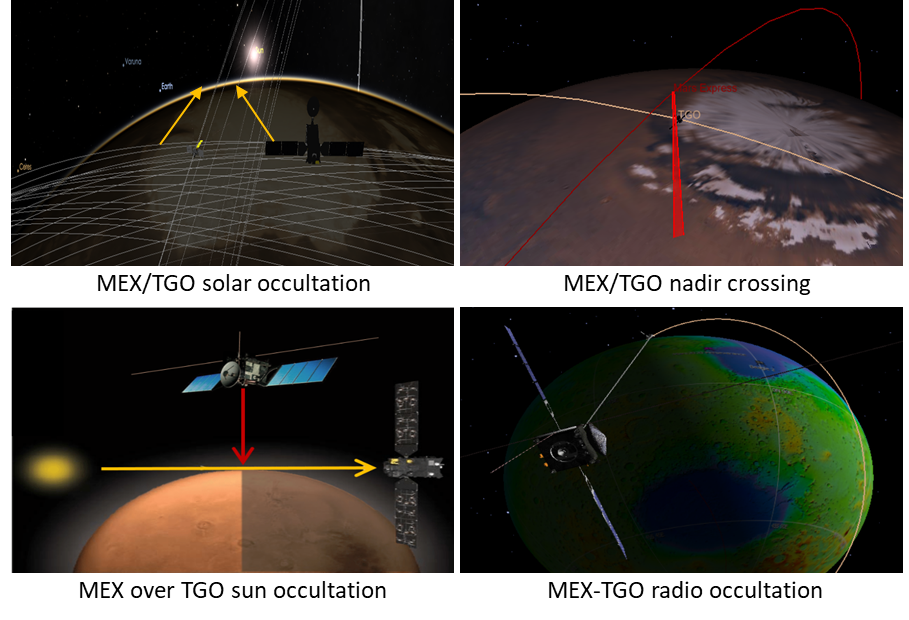Coordination of Mars Express and Trace Gas Orbiter joint observations of the Martian atmosphere in 2021-2022
- 1European Space Astronomy Centre, Spain (alejandro.cardesin@sciops.esa.int)
- 2Laboratoire Atmosphères, Milieux, Observations Spatiales, Guyancourt, France
- 3Royal Belgian Institute for Space Aeronomy, Brussels, Belgium
- 4Istituto Nazionale Astrofisica, Roma, Italy
- 5Technical University of Delft, The Netherlands
- 6European Space Research & Technology Centre, Noordwijk, The Netherlands
The scientific objectives of Mars Express (MEX) and ExoMars 2016 Trace Gas Orbiter (TGO) missions are very complementary, with increasing synergies among the science teams, in particular for the study of the atmosphere. In this contribution we summarize the coordination efforts to perform joint observations by the two European satellites around Mars until 2022, and the science opportunities for the expected mission extension until 2025.
Since the start of the TGO science operations in April 2018 we have executed hundreds of coordinated observations of the Martian atmosphere, first reported in [1,2] and extended here to 2022. The science data obtained during these coordinated observations provide useful input for cross-calibration of the instruments, comparison of atmospheric vertical profiles, and potential for the study of the temperature, composition, meteorology and climate of Mars.

Figure 1: Types of coordinated observations performed: MEX-TGO Sun Occultations (within 15min and distance <1000km), MEX-TGO Nadir crossings (simultaneous, within <5deg seen from Mars center), MEX Nadir over TGO Sun Occultation point (simultaneous within distance <500km), and MEX-TGO Radio Occ. points (tested in 2021 and run operationally in 2022 onwards)
These observations are routinely coordinated in collaboration between the Science Operations Centers (SOCs) of both missions [1, 3] and the instrument teams, in particular the spectrometers NOMAD and ACS onboard TGO [4,5] and SPICAM, OMEGA and PFS onboard MEX [6,7,8].
The various types of joint observations are represented in Figure 1. First the joint solar occultations by the spectrometers SPICAM (MEX) and ACS-NOMAD (TGO) are performed quasi-simultaneously (<15minutes difference), allowing the comparison of vertical profiles of the atmosphere in the same region (<1000km distance) both at the ingress and egress points (i.e. dusk and/or dawn terminator). Then, all spectrometers observe regularly in nadir geometry and we have so far performed hundreds of simultaneous observations of the crossing points (within ~350km, or <5deg as seen from Mars) and quasi-simultaneous observations of the same location within a few minutes difference, at various distances and illumination conditions. Then with MEX we are also observing nadir in the region of the TGO solar occultation, so vertical atmospheric profiles can be complemented with wider contextual imaging and/or temperature retrievals. Finally, in 2021 we have validated the spacecraft-to-spacecraft radio occultations [9], and started routine observations in 2022 to provide useful information of the ionosphere.
The authors acknowledge the contributions of the European Space Agency, Roscomos, all National Agencies, research institutions and teams involved in the success of the Mars Express and ExoMars 2016 missions. ExoMars is a space mission of the European Space Agency (ESA) and Roscosmos (Russia).
References:
[1] Cardesin Moinelo, A. et al: First year of coordinated science observations by Mars Express and ExoMars 2016 Trace Gas Orbiter, ICARUS 353, 2021
[2] Cardesin Moinelo, A. et al: Atmospheric observations performed simultaneously in 2020-2021 by ESA’s Mars Express and Trace Gas Orbiter, European Planetary Science Congress, Vol. 15, EPSC2021-128, 2021
[3] Geiger, B et al: Long Term Planning for the ExoMars Trace Gas Orbiter Mission: Opportunity Analysis and Observation Scheduling, Proceedings of SpaceOps Conference, 2018
[4] Vandaele, A. C. et al: NOMAD, an Integrated Suite of Three Spectrometers for the ExoMars Trace Gas Mission: Technical Description, Science Objectives and Expected Performance, Space Sci Rev 214: 80. 2018
[5] Korablev, O. et al: The Atmospheric Chemistry Suite (ACS) of Three Spectrometers for the ExoMars 2016 Trace Gas Orbiter Space Sci Rev 214: 7. 2018
[6] Montmessin et al, SPICAM on Mars Express: A 10 year in-depth survey of the Martian atmosphere. Icarus, Volume 297, p. 195-216. 2017
[7] Bibring, J.-P., et al., OMEGA: Observatoire pour la Minéralogie, l’Eau, les Glaces et l’Activité, ESA SP-1240, pp. 3–16. 2004
[8] Formisano V. et al: The Planetary Fourier Spectrometer (PFS) onboard the European Mars Express mission, Planetary and Space Science, Volume 53, Issue 10, p. 963-974. 2005
[9] Svedhem H. et al: First results from the MEX – TGO Mutual Radio Occultation Experiment, European Planetary Science Congress, Vol. 15, Vol. 15, EPSC2021-719, 2021
How to cite: Cardesin-Moinelo, A., Geiger, B., Lacombe, G., Ristic, B., Wolkenberg, P., Svedhem, H., Wilson, C., Titov, D., Martin, P., Muñiz, C., Marin-Yaseli, J., Merritt, D., Sierra, M., Esquej, P., and Ashman, M.: Coordination of Mars Express and Trace Gas Orbiter joint observations of the Martian atmosphere in 2021-2022, Europlanet Science Congress 2022, Granada, Spain, 18–23 Sep 2022, EPSC2022-136, https://doi.org/10.5194/epsc2022-136, 2022.

